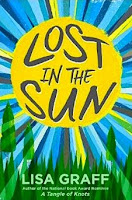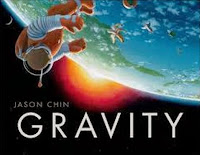
What I Read this Week:
 Nathan Hale's Hazardous Tales: The Underground Abductor, by Nathan Hale
Nathan Hale's Hazardous Tales: The Underground Abductor, by Nathan Hale
(Amulet Books, April 21, 2015)
Harriet Tubman was once Araminta "Minty" Ross, one of many children in a slave family. Her story of escape to freedom, guiding others on the Underground Railroad, and assisting in the Civil War make her a prominent example of bravery and risk-taking in American history. Nathan Hale narrates the heroic story of Harriet Tubman.
As is true for other books in the Nathan Hale's Hazardous Tales series, The Underground Abductor will capture readers' attention quickly and have them page turning as they read on to hear the (sometimes unbelievable but) true stories of our nation's history. Anecdotal information and interesting stories that are often left out of biographical texts and the side comments made by the Provost and the Hangman raise the entertainment quota.
Harriet Tubman was once Araminta "Minty" Ross, one of many children in a slave family. Her story of escape to freedom, guiding others on the Underground Railroad, and assisting in the Civil War make her a prominent example of bravery and risk-taking in American history. Nathan Hale narrates the heroic story of Harriet Tubman.
As is true for other books in the Nathan Hale's Hazardous Tales series, The Underground Abductor will capture readers' attention quickly and have them page turning as they read on to hear the (sometimes unbelievable but) true stories of our nation's history. Anecdotal information and interesting stories that are often left out of biographical texts and the side comments made by the Provost and the Hangman raise the entertainment quota.
Lost in the Sun, by Lisa Graff
(Philomel, May 26, 2015)
Trent carries around heavy feelings from the accidental death of a classmate that make him susceptible to feeling inadequate and result in days filled with nervousness and anger. Trent's struggle threatens all of his relationships--with family, teachers, and friends, including a mysterious classmate (Fallon Little) who nudges Trent towards forgiveness and an opportunity at a second chance.
Lisa Graff has given the reading world more characters to build our compassion. This was a book in which I lost track of the act of reading and was more engaged in the act of caring. I wanted better for Trent, I wanted healing and forgiveness. Though written as a companion book to Graff's previous novel Umbrella Summer, it seems to me that neither depends on the other and could be read as a stand-alone (though I don't know why you wouldn't read both).
The Princess in Black, by Shannon Hale and Dean Hale, illustrated by LeUyen Pham
(Candlewick, April 14, 2015)
Princess Magnolia lives in a pristine pink-plated castle, but when she is summoned in the middle of tea with a duchess to help fight an invading monster, her alter-ego as the Princess in Black is threatened.
The story of the Princess in Black is cute. Formatted as a short, beginning chapter book, it is a good fit for middle elementary readers who are transitioning to books of length. There is enough left unsaid in this book to lend itself to other titles in the series.
(Chronicle Books, March 31, 2015)
What do you wish for your friends and family and those important people you know? This collection of wishes for well-being will warm hearts. The language, the art, the sentiment--everything about this little book is full of big heart.
(Roaring Brook Press, 2014)
With stunning illustrations that you'll want to revisit and simple text on the pages, Jason Chin conveys the concept of gravity. This book will make a great introductory text in classrooms.
(Harry N. Abrams, 2013)
Kenichi Zenimura developed a love for baseball at a young age and pursued his dream even when his family questioned him. He grew more successful each season, but his baseball dreams were stopped short when he and his family were placed in internment camps in Arizona following the bombing of Pearl Harbor. As with most true passions, Zeni looked for a way to keep playing, creating a baseball diamond within the walls of the internment camp and rallying others to play, too.
Marissa Moss introduces us to a personality from American history that gets little attention, yet is a stunning example of the power of human spirit, hope, and resiliency. Zeni's perseverance and commitment to playing baseball again, even in the face of darkness inspired those around him during the time of war, and Barbed Wire Baseball keeps his inspiration alive for readers, too.
What I am Currently Reading:
The Junction of Sunshine and Lucky, by Holly Schindler
(Dial Books, 2014)
What I am Reading Next (in no particular order):The Iron Trial, by Holly Black
Survival Strategies of the Almost Brave, by Jen White
The Lost Track of Time, by Paige Britt



















